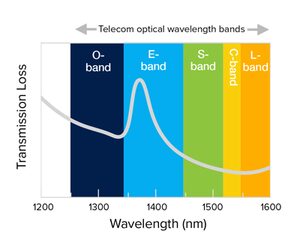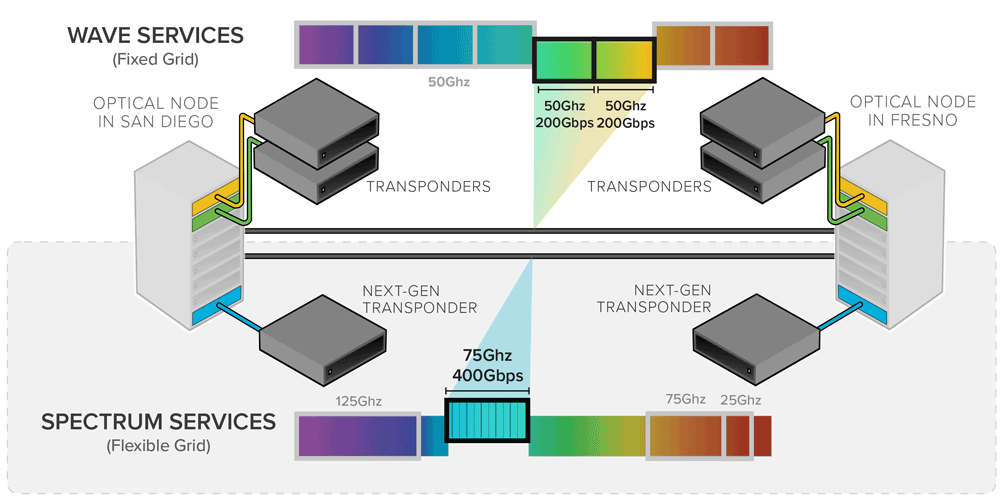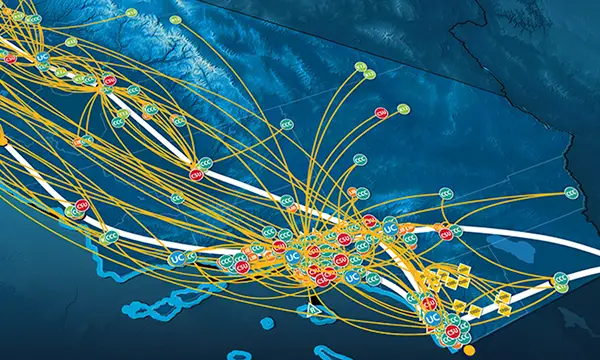- About
- Network
- Community
- Initiatives
- News
- Events
- Blog
- Publications

Doing More with Less: Balancing Network Energy Budgets through Spectrum Services
Categories RENS & NRENS Pacific Wave Technology & Innovation

Many people are familiar with the phrase “Reduce, Reuse, Recycle,” but most of them aren’t aware that the words are placed in order of effectiveness. In other words, if one is interested in using resources as efficiently as possible, the most important thing to do is reduce the resources consumed. Put plainly – do more with less.
To this end, CENIC has implemented many innovations to improve the energy efficiency of the California Research and Education Network (CalREN) while delivering ever greater capacity.
In 2010, CENIC used one full rack of equipment for 10 Gbps of data traffic, as shown in the diagram to the right. Today, we have achieved 400 Gbps or more with only 1/24th as much equipment, a major savings of space and power when one-third of network-related power consumption is related to equipment and data transmission.
The Latest Way to Do More with Less: Spectrum Services
Fiber-based networks promise to enable even more major gains in power efficiency for homes, businesses, anchor institutions, and more – but only if they themselves don’t erase any potential gains. In other words, the more data you can move with less equipment and power, the better.
CENIC’s Spectrum Services is an excellent example of an innovation in optical services that will help exceed these already impressive achievements in network energy efficiency, both for CalREN as well as for the communities CENIC was created to serve.
Spectrum Services are a special power- and equipment-thrifty subset of what are called Optical Services – the purchase and use of one or more “slices” of the total spectrum of light carried by a fiber pair, where each slice consists of a defined amount of bandwidth on either side of a central wavelength. The capacities that a carrier or last-mile provider can obtain through such services typically run into the hundreds of gigabits per second, making Optical Services equivalent to a dedicated high-performance fiber path.

The different types of Optical Services are defined by the way that the total spectrum of light carried by a fiber pair is divided into “slices.” In the Wave Services model, also known as fixed-grid, the full 4800 GHz spectrum that a typical pair of fiber-optic strands can carry is evenly divided into a fixed grid of uniform 50 GHz-wide “slices,” and services are provisioned by the “slice.” Depending on the transponder that is used to turn data signals into light pulses, each 50 GHz “slice” can carry up to 200 Gbps of data traffic. To do this, each “slice” requires a transponder on each end of the fiber pair.
However, future-facing middle-mile networks like CalREN feature the ability to provide a customer’s desired capacity on a pair of fiber strands with Spectrum Services: combining multiple much smaller “slices” (currently 6.25 or 12.5 GHz wide) into one composite “slice” of flexible size. This composite “slice” is treated as a single signal by one pair of Next-Generation Internet (NGI) transponders, which can enable considerably higher data throughputs.
In other words, to provision 400 Gbps of capacity using Wave Services, at least four transponders are required, a pair for each of the two 50 GHz “slices” of spectrum that must be purchased. Additionally, all four transponders require power, rack space, and ongoing maintenance costs.
However, provisioning 400 Gbps using Spectrum Services requires only one pair of NGI transponders and only 75 GHz worth of spectrum, composed of multiple much smaller “slices.” Therefore, half as much equipment is required, and thus half the rack space, power, and maintenance costs.
Additionally, since NGI transponders are capable of much greater capacity than the typical 200 Gbps of most transponders, customers can reach near-Terabit data rates depending on the size of the purchased “slice” of spectrum and which NGI transponder is used.
Pushing the Limits Even Further: Terabit Capacity and Beyond
While Spectrum Services enable fiber-based networks to match capacity with less equipment, coming optical innovations promise capacity far exceeding today’s technology. Thus, the 400 Gbps that a current next-generation transponder can provision over a 75 GHz wide “slice” of spectrum is just the beginning.
Using only Spectrum Services, a single optical fiber can already carry a total of 25.6 Terabits per second. However, the coherent pluggable optics already validated by CENIC (both with and without integrated amplifiers) can fit 400 Gbps into a “slice” only 65 GHz wide, boosting that number to nearly 30 Tbps.
And coherent pluggables are not the only technology where new innovations are arriving every day. Transponders are offering more and more connection ports per shelf of rack space, featuring multiple slots per unit of rack space and multiple connection ports per slot. Thus not only are transponders and pluggable optics improving in throughput, but more and more of them are fitting into a given unit of rack space.

Yet another area of coming innovation is the expansion of the spectrum of light used to carry data over an optical fiber. Light rays come in a wide range of wavelengths and frequencies, and fiber technology most often uses the subset of this range with the best performance and lowest loss, called the “C-band”. However, as shown at left, other shorter- and longer-wavelength ranges with comparably low loss exist (called S- and L-band, respectively), and equipment manufacturers have begun using them and researching them further.
Thus, once a fiber’s C-band is carrying its full capacity, these other subsets of the total light spectrum can be used to carry even more data, now and in the future.
Energy Efficiency Is More than Just Spectrum Services
In addition to making use of Spectrum Services over CalREN as well as offering it to our members, CENIC has implemented many other power efficiencies. Since air cooling uses so much electrical power, improved airflow also contributes greatly to improved power efficiency. For example, CENIC has implemented standardized hut, rack, and cabling layouts that do not impede airflow, including the placement of hotter-running equipment at the top of racks to avoid heating up any cooler-running equipment above it.
By implementing these and other process-related efficiencies, CENIC was able to reduce its power use from 343,000 to 106,000 kWh/month – a major cost savings and reduction in power consumption of over two-thirds and the equivalent of powering 270 households while still increasing capacity for its member communities.
How to Learn More
You can download our easy-to-read Middle-Mile Series in PDF format to learn about not only the different kinds of optical services available over fiber-based networks but also how middle-mile networks fit into the overall fabric of the global Internet, different build options, and the critical topic of network resiliency.
In addition, you can also download two more one-sheets focusing on broadband, energy, and the environment to learn how middle-mile networks both conserve power and equipment and enable their customers to do the same.
And please consider joining us in Monterey, California March 25-27th for The Right Connection, a conference created by and for the CENIC community, for presentations and discussions on this and other topics.
Related blog posts
The Big Game Is Big Data: How CENIC and the California Research and Education Network Support Member Athletics
When Fresno State needed to connect to Pac-12 Enterprises to broadcast a live football game over CBS, the Chancellor's Office reached out to CENIC for what Pac-12 later called the smoothest turn-up they've ever experienced.
Enabling Network-Based Collaboration Around the World: A Tour of CENIC and Partner Network Maps
On the Network Maps page at the CENIC website, you’ll find maps of all the networks, peering facilities, and exchanges to which CalREN connects, showing how thousands of CENIC member institutions connect to CalREN and to colleagues all over the globe.


